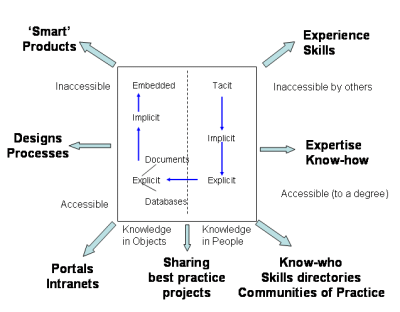Tacit and Explicit Knowledge
The distinction between tacit and explicit knowledge is perhaps the
most fundamental concept of knowledge management.
Such a distinction was first made by Michael Polyani in the 1960s, but
it forms one of the central planks of Nonaka and Takeuchi's book The Knowledge-Creating Company.
According to them, 'explicit' knowledge is formal and systematic[1]:
"Explicit knowledge can be expressed in words and numbers and can be easily communicated and shared in the form of hard data, scientific formulae, codified procedures or universal principles."
Such knowledge is seen as "only the tip of the iceberg". 'Tacit' knowledge, on the other hand, is described as:
"something not easily visible and expressible. Tacit knowledge is highly personal and hard to formalise. Subjective insights, intuitions and hunches fall into this category of knowledge."
"It is hard to formalize... difficult to communicate...deeply rooted in action and in an individual's commitment to a specific context...captured in the term 'know-how'. It consists of mental models, beliefs, and perspectives so ingrained that we take them for granted, and therefore cannot easily articulate them."
The example I like to use to illustrate tacit knowledge is that of
riding a bicycle (Polyani's original example was that of an ice skater).
The explicit knowledge for this might be a set of instructions along
the lines of:
1. Stand besides your bike, hold both the handlebars and look forward.
2. Walk briskly forward or run a few paces taking the bike with you.
3. Now mount the bike, putting one foot on each pedal
4. Start pedalling while maintaining you balance
5. If you start to swerve or lose balance steer the bike into the direction in which you are falling.
etc. etc.
But would this convey the knowledge - the skill to ride a bicycle?
The knowledge comes through that 'ah-ha' moment, and the ability to repeat it without thinking.
You may have had someone to coach you and most likely hold the bike to help you balance.
And you gain confidence with experience.
Such knowledge (e.g. steps 4 and 5 above) is indeed difficult to put into words.
It is embedded in your brain and you use it subconsciously.
The Tacit - Explicit Spectrum ... and more besides
Although we have expressed here and in the knowledge hierarchy a
clear distinction between tacit and explicit knowledge, this is really
an oversimplification.
Some explicit knowledge, such as factual knowledge can be made
portrayed as very precise.
Other types,
such as the know-what and know-why may be less clear cut.
There is also potential lack of clarity if not articulated in precise
terms that leaves no room for ambiguity (we all know about politician's
summit agreement communiques, or statements made by both parties after
an industrial dispute!).
At the other end of the spectrum there is deep tacit knowledge,
such as belief and judgement, which is very personal and extremely
difficult to transfer to other people.
On the other hand quite a lot of tacit knowledge, with good 'knowledge
harvesting' or elicitation, can be made explicit.
There is also implicit knowledge, which may be present in some
combination of explicit and tacit knowledge but needs people to extract
it.
An example might be product knowledge that only becomes apparent
through reverse engineering.
The diagram below elaborates on the simple tacit-explicit split and
shows examples of their manifestations.
 The transfer of tacit knowledge throughout an enterprise involves
complex processes, including the conversion from tacit to explicit, and
vice versa.
The different conversion processes are described on the knowledge spiral page.
The transfer of tacit knowledge throughout an enterprise involves
complex processes, including the conversion from tacit to explicit, and
vice versa.
The different conversion processes are described on the knowledge spiral page.Reference
1. The Knowledge-Creating Company: How Japanese Comapnies Create the Dynamics of Innovation, Ikujior Nonaka and Hirotaka Takeuchi, Oxford University Press (1995) - see our book review.
Deepa Singh
Business Developer
Web Site:-http://www.gyapti.com
Blog:- http://gyapti.blogspot.com/
Email Id:-deepa.singh@soarlogic.com
Deepa Singh
Business Developer
Web Site:-http://www.gyapti.com
Blog:- http://gyapti.blogspot.com/
Email Id:-deepa.singh@soarlogic.com
No comments:
Post a Comment